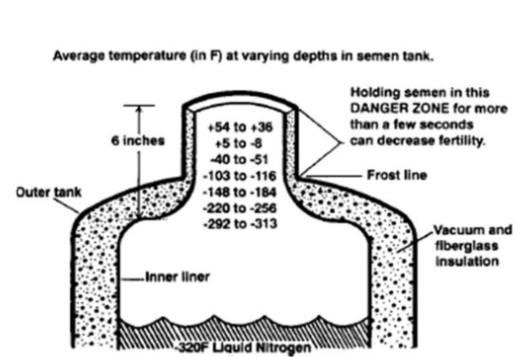By Olivia Amundson
Proper semen handling is crucial for the overall reproductive success of an operation utilizing artificial insemination. Artificial insemination is used to enhance the production potential of the operation, rapidly implement new genetics or consolidate calving. It is important that certain steps are followed to ensure the semen is thawed, handled and deposited appropriately. Without proper storage and handling at all stages, sperm cells can die rapidly and compromise the likelihood of success, costing a producer both time and money.
Equipment
Proper equipment is essential for the success of artificial insemination. Equipment needed includes: a nitrogen tank (personal tank or a shipper tank), AI gun(s), plastic sheaths that match your chosen AI gun, OB shoulder-length gloves, straw cutter (scissors), water bath, stop-watch, tweezers, paper towels and non-spermicidal lubrication. Artificial insemination box kits can be purchased, however, a plastic or stainless steel toolbox works to organize and protect the equipment and keep it clean and dry. When cleaning equipment, use a 70% isopropyl alcohol, disinfectants and/or soap. Always thoroughly rinse with water; disinfectants coming in contact with a straw of semen can be lethal to the spermatozoa.
Semen Storage
Beef semen is frozen and stored in liquid nitrogen. Liquid nitrogen is around -320°F and rate of evaporation depends on tank construction and size. It’s important to maintain the tank in a clean, dry, well-ventilated location. Do not store tanks on concrete, as alloys within the concrete can be corrosive to the tank. If a tank is stored on concrete, place a wooden pallet or some type of platform underneath to disrupt unnecessary exposure. Check nitrogen level regularly. This can be accomplished using a yard stick or even piece of rebar, for example. Refilling should occur when there is approximately 4 cm of nitrogen left. If no evaporation is seen when pulling out the plug, this is an indication of a tank that has gone dry.

Adapted from Agupdate.com
Removing Semen from the Tank
Decreasing the straw of semen’s number of exposures to warmer temperatures will help eliminate fluctuations in semen quality. Removing semen from the tank should occur quickly and efficiently. A frost line occurs around -103 and -106°C, as the canister moves up the neck of the tank, the temperature decreases. When semen is held above the frost line, a decrease in fertility can occur, as slight warming can cause sperm cells to die. If the desired straw cannot be located within 7-10 seconds of lifting the canister, the canister should be placed back into the liquid nitrogen for 10-15 seconds before re-locating the straw of semen. To assist in locating a straw of semen from a canister, a tweezers or forceps should be used. It’s important to avoid using fingers to grab at a straw of semen, as the heat of the hands can cause the straw to begin to thaw and again decrease the fertility of that semen. Essentially, semen is a delicate biological product, and all temperature fluctuations will decrease semen quality to some degree.
Thawing Semen
To begin thawing semen, the desired straw of semen must be located properly from the tank using a tweezers or forceps and maintaining the canister below the frost line. Once the straw of semen has been located and secured, the straw of semen needs to be placed immediately into a water bath containing 95-98°F water. Straws of semen must be thawed using a water bath unless stated otherwise. Some companies produce straws of semen that qualify for pocket thawing, however, these are still inferior to thawing in a water bath at the correct temperatures.
The straw of semen should be placed in the water bath for a minimum of 30 seconds and no longer than 15 minutes. The number of straws thawed at one time should not exceed four, as the water bath temperature will begin to decrease and cause semen fertility to go down. It is not uncommon for multiple cows to be in heat at once, therefore, several straws of semen may be thawed at once. Remember to thaw only the amount of straws that can successfully be inseminated within a 15-minute period (from the time it went into the water bath until it was deposited into the uterine body of the cow).
After thawing, dry the straw of semen completely, check identification on the straw to ensure the correct bull is being used, cut the top of the straw opposite of the cotton plug, and finally load into an insemination gun. Once the gun is loaded, protect the gun from cold environments. This can be accomplished by placing the gun next to the body or utilizing a gun warmer to maintain a constant temperature. Remember that any rapid changes or contaminants can compromise the quality of the semen in a straw, including excess heat or cold, direct sunlight, sweat, blood, water, urine and manure. At this point you are ready to inseminate a cow. Ensure correct insemination technique when depositing the semen. Deposit semen after the cervix and before the bifurcation of the uterine horns.
Source : sdstate.edu